Tegalalang Rice Terrace, an enchanting tapestry of emerald hues and cascading waters, beckons travelers to immerse themselves in the heart of Bali’s rural charm. Nestled amidst the lush highlands of Ubud, this UNESCO World Heritage Site is not just a breathtaking landscape but a living testament to centuries-old traditions and a vibrant local culture.
Sculpted by generations of skilled farmers, the intricate network of rice paddies descends down the contours of the land, creating a mesmerizing spectacle that has captivated countless visitors. The gentle sway of rice stalks, the melodious sound of water flowing through irrigation channels, and the panoramic views of the surrounding jungle paint a picture of serenity and timeless beauty.
Tegalalang Rice Terrace Overview
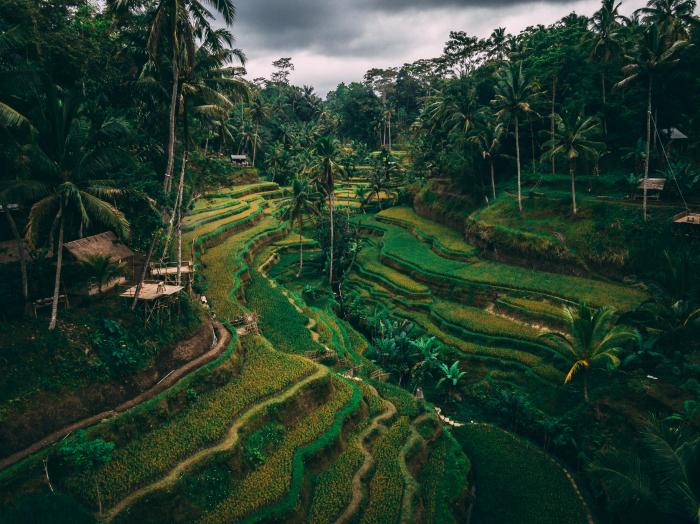
Tegalalang Rice Terrace is a beautiful and iconic rice terrace located in the village of Tegalalang, Ubud, Bali, Indonesia. It is situated in the central highlands of Bali, approximately 20 kilometers north of Ubud. The rice terrace is surrounded by lush green hills and offers breathtaking views of the surrounding countryside.The rice terrace is a UNESCO World Heritage Site and is considered one of the most important cultural landscapes in Bali.
Tegalalang Rice Terrace is a must-visit destination in Bali, known for its lush greenery and stunning views. If you’re looking for a convenient and hassle-free way to explore this natural wonder, consider booking a tour with Golden Rama Tour and Travel.
They offer a variety of packages that cater to different interests and budgets, ensuring you have an unforgettable experience at Tegalalang Rice Terrace.
It is a living example of the traditional subak irrigation system, which has been used for centuries to irrigate the rice fields. The subak system is a complex network of canals and tunnels that distribute water from the surrounding hills to the rice fields.Tegalalang Rice Terrace is a popular tourist destination and is visited by millions of people each year.
The rice terrace is open to the public and there are a number of walking trails that lead through the fields. Visitors can also take a guided tour of the rice terrace and learn about the history and culture of the area.
Historical Significance
The Tegalalang Rice Terrace is a living example of the traditional subak irrigation system, which has been used for centuries to irrigate the rice fields in Bali. The subak system is a complex network of canals and tunnels that distribute water from the surrounding hills to the rice fields.
The system is a testament to the ingenuity and engineering skills of the Balinese people.The Tegalalang Rice Terrace is also a cultural landscape of great importance. The rice terrace is a symbol of the Balinese people’s close relationship with nature and their dependence on rice cultivation.
The rice terrace is also a place of religious significance and is often used for ceremonies and rituals.
Geography
The Tegalalang Rice Terrace is located in the central highlands of Bali, approximately 20 kilometers north of Ubud. The rice terrace is situated on a hillside and is surrounded by lush green hills. The rice terrace is irrigated by a complex network of canals and tunnels that distribute water from the surrounding hills to the rice fields.The Tegalalang Rice Terrace is a popular tourist destination and is visited by millions of people each year.
The rice terrace is open to the public and there are a number of walking trails that lead through the fields. Visitors can also take a guided tour of the rice terrace and learn about the history and culture of the area.
Size
The Tegalalang Rice Terrace is one of the largest rice terraces in Bali. The rice terrace covers an area of approximately 120 hectares and is home to over 1,000 farmers. The rice terrace is divided into a number of smaller terraces, each of which is irrigated by a separate canal.
Elevation
The Tegalalang Rice Terrace is located at an elevation of approximately 600 meters above sea level. The rice terrace is situated on a hillside and offers breathtaking views of the surrounding countryside.
Number of Terraces
The Tegalalang Rice Terrace is divided into a number of smaller terraces, each of which is irrigated by a separate canal. The number of terraces varies depending on the source, but it is generally agreed that there are over 1,000 terraces in total.
Natural Beauty and Landscape
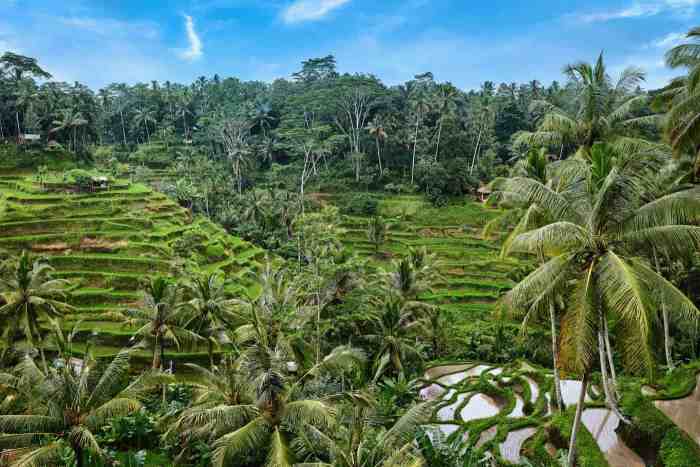
Tegalalang Rice Terrace is renowned for its breathtaking vistas and awe-inspiring scenery. The lush vegetation, cascading waterfalls, and unique rock formations create a harmonious symphony of nature’s artistry.
The verdant rice paddies, meticulously carved into the undulating hillsides, form an emerald tapestry that stretches as far as the eye can see. The intricate network of irrigation channels, snaking through the fields like silver ribbons, adds to the picturesque charm of the landscape.
Cascading Waterfalls
Amidst the verdant rice terraces, several cascading waterfalls plunge down the steep slopes, creating a symphony of sound and movement. The crystal-clear waters shimmer in the sunlight, reflecting rainbows that dance across the spray. The thunderous roar of the falls adds an exhilarating element to the serene surroundings.
Unique Rock Formations
Scattered throughout the rice terraces are unique rock formations, remnants of ancient volcanic activity. These colossal boulders, shaped by eons of erosion, add a touch of ruggedness to the otherwise idyllic landscape. Some of these formations resemble mythical creatures, while others evoke a sense of mystery and wonder.
Biodiversity and Ecological Significance, Tegalalang rice terrace
The Tegalalang Rice Terrace is not only a visual masterpiece but also a haven for biodiversity. The diverse ecosystem supports a wide range of flora and fauna. The lush vegetation provides a habitat for numerous bird species, while the cascading waterfalls attract a variety of aquatic life.
The intricate irrigation system, meticulously designed over centuries, ensures a sustainable water supply for the rice paddies and the surrounding environment. The rice terraces, therefore, play a crucial role in maintaining the ecological balance of the region.
Tourism and Activities

Tegalalang Rice Terrace has gained immense popularity as a tourist destination due to its picturesque scenery, lush greenery, and serene atmosphere. The rice terraces, meticulously carved into the hillside, create a stunning visual spectacle that attracts visitors from around the world.
The area offers a wide range of activities to cater to diverse interests. Visitors can embark on scenic treks through the rice paddies, capturing breathtaking panoramic views of the surrounding landscape. Photography enthusiasts can indulge in capturing the vibrant hues and intricate patterns of the rice terraces, making for unforgettable memories.
After exploring the scenic Tegalalang Rice Terrace, indulge in a delightful culinary experience at Jimbaran Bay. Savor the freshest jimbaran seafood grilled to perfection, while enjoying the breathtaking sunset views. The aromatic spices and succulent flavors will tantalize your taste buds, creating a memorable dining experience.
Return to Tegalalang Rice Terrace refreshed and ready to continue your exploration of its lush landscapes.
Cultural Tours
Cultural tours are another popular activity at Tegalalang Rice Terrace. These tours provide insights into the traditional farming practices, local customs, and daily life of the Balinese farmers who cultivate the rice paddies. Visitors can learn about the intricate irrigation system, the significance of rice in Balinese culture, and the role of the local community in preserving this agricultural heritage.
Infrastructure and Facilities
Tegalalang Rice Terrace is well-equipped with infrastructure and facilities to enhance the visitor experience. Visitors can find numerous restaurants, cafes, and souvenir shops offering local delicacies, refreshments, and handicrafts. There are also designated parking areas, restrooms, and walkways to ensure the convenience and safety of tourists.
Cultural and Spiritual Significance
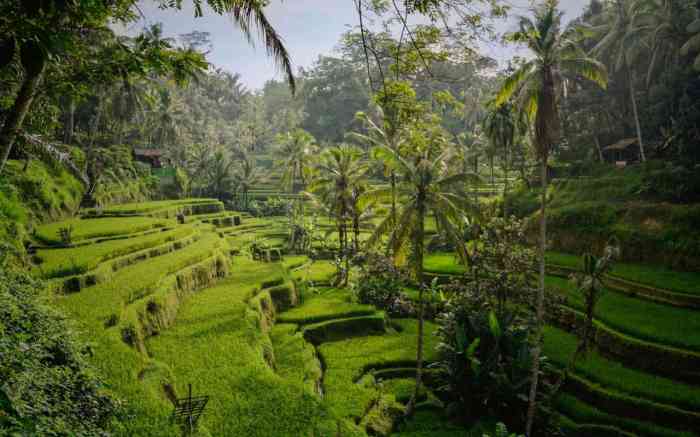
The Tegalalang Rice Terrace is not just an agricultural marvel but also holds immense cultural and spiritual significance for the local community. The traditional farming practices and rituals associated with the rice terrace reflect the deep connection between the people and their land.
The rice terrace is an integral part of the local community’s cultural heritage. The intricate irrigation system and the unique cultivation techniques have been passed down through generations, showcasing the ingenuity and resilience of the Balinese people.
Traditional Farming Practices
- The rice terrace is cultivated using the traditional subak irrigation system, which is a UNESCO-recognized cultural heritage.
- Farmers follow a specific calendar of planting, harvesting, and rituals to ensure a bountiful harvest.
- The use of organic fertilizers and natural pest control methods reflects the community’s commitment to sustainable farming.
Spiritual Beliefs and Ceremonies
- The rice terrace is considered a sacred place, and various ceremonies are held throughout the year to honor the rice goddess, Dewi Sri.
- Offerings are made to the goddess to ensure a successful harvest and to express gratitude for the land’s bounty.
- The rice terrace is also a place of meditation and reflection for the local community.
Economic Impact and Sustainability
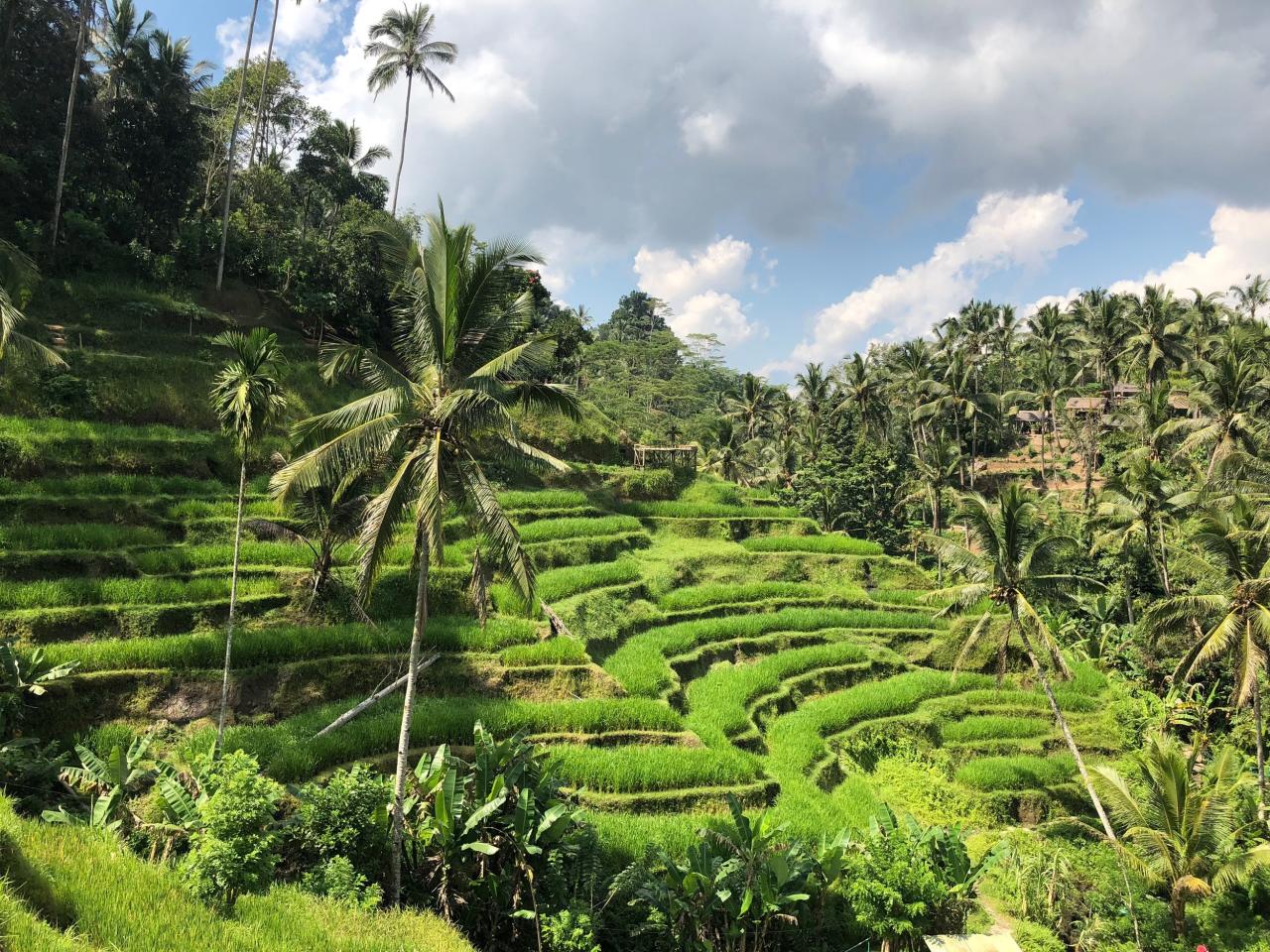
Tegalalang Rice Terrace contributes significantly to the local economy through tourism and agriculture.
After a day of exploring the lush Tegalalang Rice Terrace, consider unwinding at the iconic Rock Bar Bali. Perched on the edge of a limestone cliff, this legendary bar offers breathtaking sunset views and an unforgettable ambiance. Return to the serenity of Tegalalang Rice Terrace, where you can immerse yourself in the tranquil beauty of its emerald-green paddies and cascading waterfalls.
The stunning scenery attracts tourists worldwide, generating revenue for local businesses such as restaurants, homestays, and tour operators. Moreover, the terrace is a vital source of income for farmers, who cultivate rice and other crops on the fertile land.
Challenges and Opportunities for Sustainable Development
While tourism brings economic benefits, it also poses challenges to the sustainability of the rice terrace. The influx of visitors can lead to pollution, waste generation, and soil erosion. Balancing economic development with environmental preservation is crucial.
- Opportunities:
- Promoting sustainable tourism practices, such as encouraging responsible waste disposal and limiting the use of plastic.
- Developing eco-friendly accommodations and tour packages.
- Investing in infrastructure to minimize environmental impact, such as improved waste management systems and trails.
- Challenges:
- Managing the volume of tourists without damaging the fragile ecosystem.
- Ensuring that tourism benefits the local community and does not lead to displacement or exploitation.
- Balancing the need for economic growth with the preservation of the rice terrace’s cultural and spiritual significance.
Conservation Efforts and Community Initiatives
Recognizing the importance of sustainability, various conservation efforts and community initiatives have been implemented:
- Community-based tourism:Local cooperatives have been established to manage tourism activities and ensure that revenue benefits the community.
- Organic farming practices:Farmers are encouraged to use organic fertilizers and pest control methods to minimize environmental impact.
- Waste reduction programs:Campaigns have been launched to promote responsible waste disposal and reduce plastic pollution.
- Educational initiatives:Schools and community groups conduct educational programs to raise awareness about the importance of preserving the rice terrace.
Design and Architecture

The Tegalalang Rice Terrace showcases a remarkable design and construction that has been meticulously crafted over generations. The terraces are ingeniously carved into the hillside, creating a stunning landscape of verdant rice paddies cascading down the slopes.
Irrigation System and Water Management
The terrace’s design incorporates an intricate irrigation system that ensures an optimal water supply for the rice crops. The water is sourced from the nearby Ayung River and channeled through a network of aqueducts and bamboo pipes. The water flows down the terraces, irrigating each level before being collected in reservoirs at the base.
This efficient water management system allows for year-round cultivation of rice.
Aesthetic and Functional Layout
The layout of the Tegalalang Rice Terrace is both aesthetically pleasing and functional. The terraces are arranged in a series of cascading steps, with each level surrounded by earthen walls. These walls serve to retain water and prevent erosion, while also providing a visual contrast to the lush greenery of the rice paddies.
The intricate patterns and shapes created by the terraces are not only visually stunning but also have practical benefits. The curved edges of the terraces reduce water loss through evaporation, while the stepped design allows for efficient drainage and prevents waterlogging.
Comparisons and Contrasts
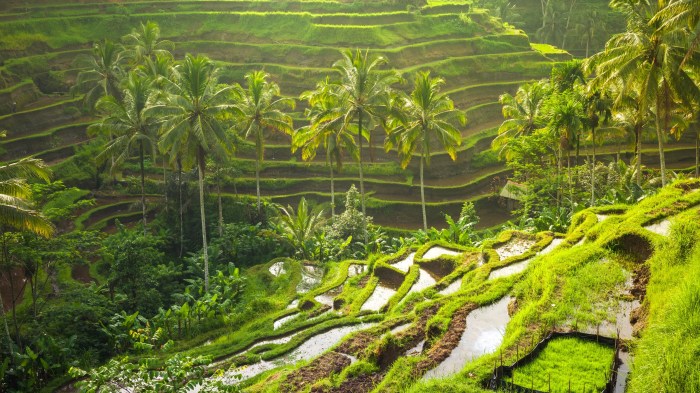
Tegalalang Rice Terrace stands out among the world’s renowned rice terraces, offering unique characteristics that set it apart. While sharing similarities in agricultural practices and scenic beauty, Tegalalang possesses distinct features that contribute to its global recognition.
Size and Location
Tegalalang is relatively smaller in size compared to the sprawling rice terraces of Banaue in the Philippines or the vast paddy fields of Yuanyang in China. Its compact layout, nestled amidst lush greenery and steep slopes, creates a picturesque landscape.
Located in the highlands of Bali, Tegalalang benefits from the island’s tropical climate and abundant rainfall, fostering lush vegetation and vibrant rice cultivation.
Cultural Significance
All rice terraces hold deep cultural and spiritual significance within their respective communities. Tegalalang is no exception, playing an integral role in the religious rituals and traditions of the local Balinese people. The intricate irrigation system known as Subak, a UNESCO-recognized heritage, is a testament to the collective wisdom and harmony with nature that has sustained the terrace for centuries.
Unique Features
Tegalalang distinguishes itself through its verdant slopes, adorned with palm trees and tropical vegetation. The presence of numerous pathways and viewpoints allows visitors to immerse themselves in the beauty of the rice fields from various angles. The iconic rice paddies, known locally as “sawah,” form intricate patterns that create a breathtaking visual spectacle.Moreover, Tegalalang has become a popular tourist destination, attracting visitors from around the world.
Its proximity to cultural attractions and other natural wonders in Bali makes it an ideal stop on any itinerary. The combination of stunning scenery, cultural heritage, and accessibility sets Tegalalang apart from other rice terraces globally.
Visuals and Multimedia

Tegalalang Rice Terrace offers a breathtaking visual experience that can be captured and shared through various multimedia platforms.
High-quality images showcasing the intricate patterns, lush greenery, and serene atmosphere of the rice terrace are essential for promoting its beauty and attracting visitors.
Virtual Tour and Interactive Map
A virtual tour or interactive map can provide users with an immersive experience of the rice terrace from the comfort of their homes.
- This allows them to navigate through the different sections of the terrace, explore the surrounding areas, and gain a better understanding of its layout and features.
- Interactive elements, such as 360-degree panoramas or guided tours, can enhance the user experience and make the virtual tour more engaging.
Videos
Videos can effectively capture the vibrant atmosphere and activities of the Tegalalang Rice Terrace.
- From showcasing the daily life of local farmers to capturing the stunning sunsets over the rice paddies, videos provide a dynamic and immersive way to experience the terrace’s beauty and cultural significance.
- Time-lapse videos can also be used to demonstrate the changing seasons and the growth cycle of the rice.
Local Cuisine and Specialties: Tegalalang Rice Terrace
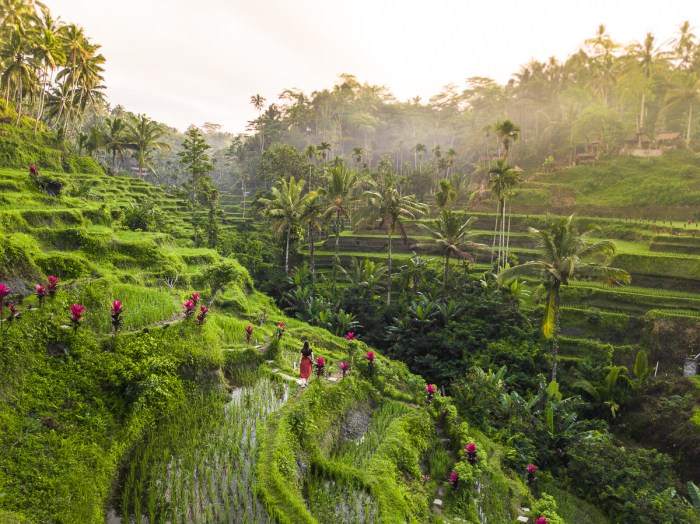
The Tegalalang region is renowned for its culinary heritage, which is deeply rooted in the flavors and ingredients of the rice terrace. The local cuisine is a symphony of fresh produce, aromatic spices, and traditional cooking techniques, creating dishes that are both flavorful and authentic.
One of the most iconic dishes associated with Tegalalang is Nasi Campur, a mixed rice dish served with various side dishes. The rice is typically cooked in coconut milk, giving it a rich and creamy flavor. The side dishes may include grilled meats, vegetables, and a variety of sambals (Indonesian chili sauces).
Traditional Delicacies
- Lawar: A traditional Balinese salad made with minced meat, vegetables, and spices.
- Sate Lilit: Grilled minced meat skewers marinated in a blend of spices and coconut milk.
- Bubur Injin: A sweet black rice porridge with coconut milk and palm sugar.
- Pisang Rai: Fried banana fritters coated in a crispy batter.
Final Summary

Tegalalang Rice Terrace stands as a testament to the harmonious coexistence between humanity and nature. Its stunning vistas, rich cultural heritage, and sustainable practices make it a must-visit destination for anyone seeking a glimpse into the soul of Bali. Whether you’re an avid photographer, a nature enthusiast, or simply someone who appreciates the beauty of the world, Tegalalang Rice Terrace promises an unforgettable experience that will linger in your memories long after your visit.
Expert Answers
What is the best time to visit Tegalalang Rice Terrace?
The best time to visit is during the dry season, from April to October, when the skies are clear, and the rice paddies are at their most vibrant green.
How do I get to Tegalalang Rice Terrace?
You can reach Tegalalang Rice Terrace by car or motorbike from Ubud. The journey takes about 30 minutes.
Are there any entrance fees for Tegalalang Rice Terrace?
Yes, there is a small entrance fee of around 10,000 Indonesian rupiah (less than $1) per person.
What activities can I do at Tegalalang Rice Terrace?
Besides admiring the stunning views, you can also enjoy trekking, photography, and cultural tours. There are also several restaurants and cafes where you can relax and savor the local cuisine.